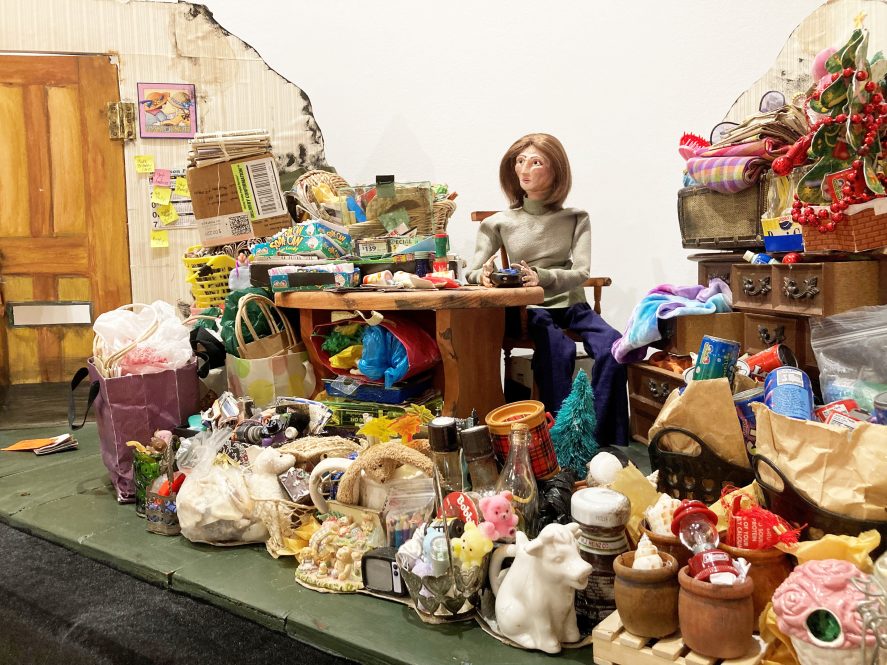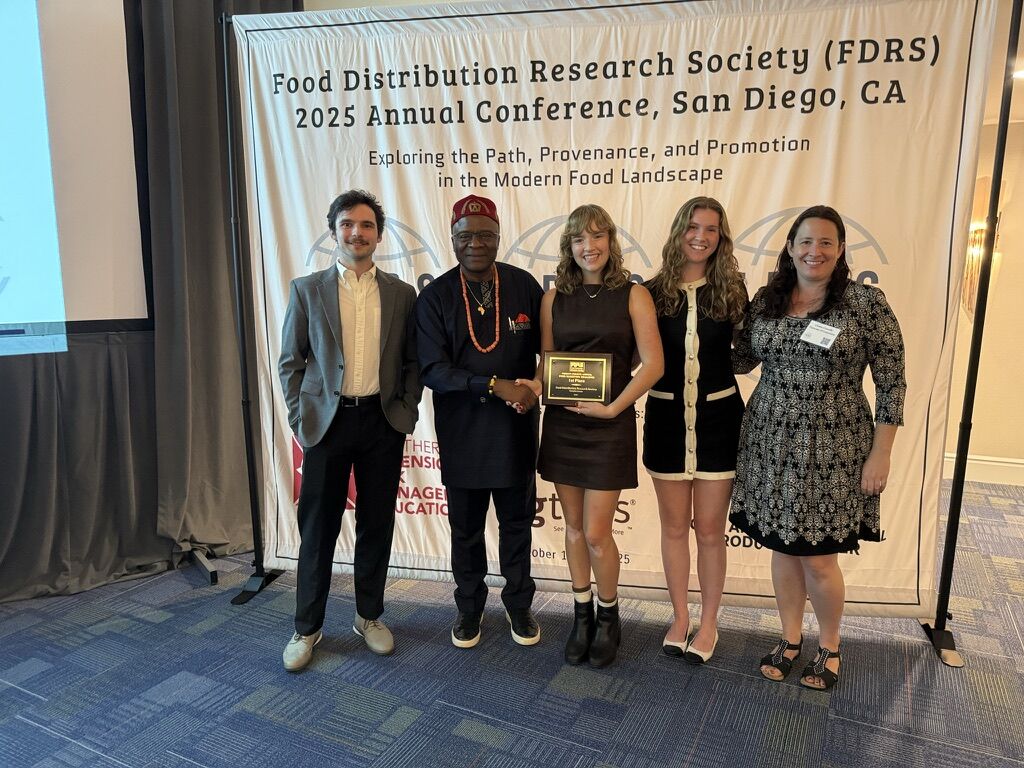Walking through the Ballard Institute and Museum of Puppetry these days is like thumbing through a “Who’s Who” of major contributors to the field of puppet arts.
Names like Stephen Kaplin ’79 (SFA), Mary Hildebrand Nagler ’12 MFA, and Esme Roszel ’20 (SFA), to name only a few, are in boldface on placards next to the fabric, foam, felt, foil, and folded paper creations they either conceived, created, or contributed to.
Someone like Janibeth Johnson ’68 (CLAS) is credited with being an innovator of overhead projector shadow theater, in which one uses a typical classroom projector to bring to life shadow puppets like Hajj, which she designed and fabricated as a UConn student.
During the pandemic when stage performances were scarce, Austin M. Costello ’15 (SFA) used Unicorn Lawyer to entertain on Instagram, while Mark Blashford ’17 MFA delighted with his Doorstep Marionette birthday telegram those who celebrated in lockdown.
Indeed, Barbara A. Pollitt ’79 (SFA) shares an alma mater with Heather Asch ’91 (SFA) and Felicia Cooper ’21 MFA though they graduated decades apart. They and all the others are connected through the legendary Frank Ballard, founder of UConn’s world-renowned Puppet Arts program and influencer to students then and now.
UConn Puppet Arts, part of the Department of Dramatic Arts in the School of Fine Arts, celebrates its 60th anniversary this year and the Ballard Institute and Museum’s latest exhibition, “Art, Movement, Imagination: 60 Years of UConn Puppeteers,” serves as a love letter to the program and its eponym.
The puppets can make us laugh and cause us to cry. They can inspire us to action and give us ideas to contemplate. Reality and fantasy are equally expressed through the puppet arts. Well presented puppetry can be magic. — Bart P. Roccoberton Jr., Professor and Director of Puppet Arts
“UConn puppetry is everywhere in the field across the United States, Europe, and Asia. It’s ubiquitous,” says John Bell, the exhibition’s co-curator and museum director. “UConn puppeteers uniformly do really good work in designing and building and performing. You just know if puppeteers are coming from UConn, they’re going to be working at a high level.”
From ‘Sesame Street’ to ‘Avenue Q’ With a Stop at Studio 8H
It all started with Ballard, who joined UConn in 1956 to teach set design and serve as the technical director of the Harriet Jorgensen Theatre, but who continually advocated for a full-fledged puppetry program at the University. A Master of Fine Arts was created in 1965, a year after Ballard taught the University’s first puppetry course, and in 1968, a bachelor’s and Master of Arts were added.
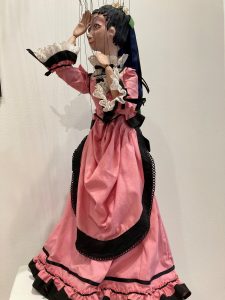
“Frank had a really big impact on UConn. Without him there wouldn’t be a program,” says Bart P. Roccoberton Jr., who studied under Ballard and succeeded him as Puppet Arts director in 1990. “Without Frank, UConn Puppet Arts wouldn’t be on the map as the only degree-granting program of its kind in the United States.”
Ballard’s marionette, Josephine, built for Connecticut Repertory Theatre’s 1989 performance of “H.M.S. Pinafore,” begins the museum’s exhibition that showcases UConn alums’ work in the fields of innovation, performance, fabrication, and education.
From Maggie Flanagan ’20 MFA, whose “Stop-Motion Scale Sample Dress” is on loan from LAIKA Studios, to Brad Williams ’92 MFA, whose Ebenezer T. Squint from Nickelodeon’s “Pinwheel” is just as green up close, the exhibition includes 40 pieces and more than 100 alums who’ve made their mark.
“To the trained puppeteer’s eye, I can see how these artists have influenced one another,” says Matthew Sorensen ’19 MFA, who co-curated the exhibition with Bell and is a visiting professor of puppetry. “It’s interesting to see all these influences and all the global traditions of puppetry on display come together cohesively, which of course is the spirit of puppetry.”
One cannot talk about UConn’s puppetry program without noting its longtime association with programs like “Sesame Street,” where many alums, including Richard Termine ’78 MFA, cut their teeth as young professionals or continued already thriving television careers, nominated for – and in many cases winning – Emmy Awards.
Pam Arciero ’81 MA worked on “Blue’s Clues,” in which she performed and voiced Polka Dots Blue. Jennifer Barnhart ’94 (SFA) performed with Trekkie Monster in the Broadway show “Avenue Q.” David Rudman ’85 (SFA) founded Spiffy Pictures, which begot “Jack’s Big Music Show” on Noggin and Nick Jr. John Cody ’17 (SFA) performed with SpongeBob SquarePants The Magic Conch Shell in “SpongeBob’s Pineapple Playhouse.” And Frankie Cordero ’04 (SFA) fabricated Pink Mouse for the PBS show “Donkey Hodie.”
So, don’t assume UConn-trained puppeteers are starving artists.
“UConn alumni puppeteers oftentimes build in large shops like Monkey Boys Productions in Pennsylvania, which does work for ‘Saturday Night Live,’” Bell says. “If you see a puppet on SNL, and that happens relatively often, it quite possibly is the work of a UConn alum.”
Members of the Same Tight-Knit Community
Sorensen says the puppet community is a tight-knit group with this person having contact information for that person, and so on. Between these personal connections and social media solicitations, the exhibition’s planning committee sought photographic examples of work from grads, then debated which best told the story of UConn Puppet Arts and which would comprise the show.
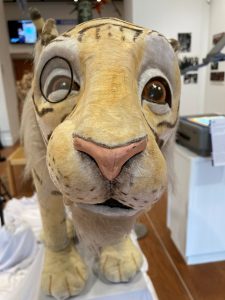
One unusual example they chose came from seven UConn fine arts alums – Susan Tolis ’92 (SFA), Joyce Ritz ’96 MFA, David Regan ’01 (SFA), Carol D’Agostino ’97 (SFA), Bob Ritz ’93 MFA, Rolande Duprey ’79 (SFA), and Robert Laughlin ’89 (SFA) – who in 1998 created the puppet show, “The Legend of the Charter Oak,” for the Old State House in Hartford.
Bell explains that Laughlin was hired to form a puppet troupe and develop a show that told the story of Connecticut’s legendary Charter Oak. The show used as character inspiration the taxidermy animals formerly on display in the Old State House’s museum of curiosities.
This meant puppets like the tiger, heron, and crocodile at the center of the Ballard Institute and Museum’s exhibition were anthropomorphized into real-life people like Joseph Wadsworth, who famously took the state’s charter in 1687 and hid it in a tree.
“UConn puppet alumni in the community who are doing different things routinely work together,” Bell says, adding the exhibition itself has been a reason for many to return to Storrs and reconnect with old friends.
Sorensen says he, Bell, and Roccoberton traded off speaking during an opening reception tour, standing aside if they saw the maker of a particular piece was on hand and had a story to contribute.
“Susan Tolis operated the marionette of Josephine in ‘H.M.S. Pinafore,’ and she told a great anecdote about working with Frank Ballard,” Sorensen says. “She was struggling to make a very long marionette work, and Frank, even though he was quite elderly and had Parkinson’s, climbed up on the marionette bridge and just whipped the puppet around and made the most beautiful gesture. It was a special opening, not only to have all that energy but their memories and personal anecdotes.”
Roccoberton’s Red Queen puppet stands tall in the back corner of the museum – her eyes fixed on the smaller puppets below, just as a royal’s gaze would. He designed and fabricated her 10-foot-tall frame for State Farm Insurance, which commissioned a stage show with a Broadway-caliber cast for company events in Chicago and Las Vegas. The show used the story of “Alice in Wonderland” to talk about insurance.
“When first asked to create the Red Queen, I was given a design and asked to fabricate it in a way that would have been terribly heavy,” Roccoberton ’90 MFA recounts. “I gained permission to redesign the character using a paper sculpture technique taught to me by Albrecht Roser, a German puppet master who was a guest artist when I was a student in 1977. The new figure weighed less than a quarter of the original request and had a fluidity on the stage that was remarkable for a 10-foot figure.”
Sorensen says he designed and fabricated Black Bird for the theater show, “Afterlife: A Ghost Story,” put on by a company in Troy, New York. “Afterlife” tells the story of a couple whose child is swept out to sea during a storm and considers what happens after death.
The fantastical bird is built of detritus churned up during the storm, he says, a perfect example of his “found object phase of building” and uses fishing nets to fill out the wings and rake heads as a train of tail feathers.
“I love fabricating. I can make a foam Muppet-esque puppet. I can carve wood, but this is my new jam,” Sorensen says of readapting everyday objects. “It’s just finding things and assembling them in imaginative ways.”
Building a Foundation with Wooden Reeds
Take another example, this one from Penny Benson ’15 MFA, whose Prancer the Reindeer was designed for a production of “Prancer,” a play about Santa’s reindeer. The animal comes together thanks to a series of bent wooden reeds to create the animal’s shape, tufts of raffia for the mane, burlap skin and hooves, along with metal internal mechanisms for movement and zip ties to hold it all together.
“I love the way she’s using all these different materials. It’s ingenious,” Bell says, explaining that Prancer’s puppeteer would be visible to the audience during the performance, human form becoming part of the beast. “It’s a beautifully innovative puppet. It’s not trying to be realistic. It’s wanting to show you the materials.”
Most of Prancer’s skeleton is airy, although Benson bent the wooden reeds around her hips at the top of her rear legs so they bulge where her muscles naturally would protrude, giving the feeling of a solid animal.
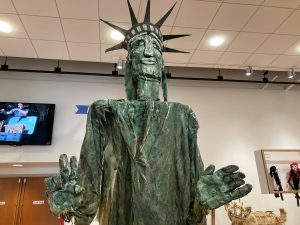
“One of the things I love about puppetry is when you leave an empty space, then the viewer, the audience, gets to fill that in,” Sorensen says. “In a sense, an abstract puppet is easier to connect with emotionally than an incredibly well-made replica. The more abstract, the more space we leave for the imagination, the more effective it can be on stage.”
But how does someone learn to sculpt that way?
“That’s a technique that we teach,” Sorensen says of bending wood. “It doesn’t come up a lot, but if we’re doing a project that calls for it, we’d show the student how to take the reed, soak it, and shape it. It’s a centuries-old technique that appears in a lot of puppetry traditions globally.”
He continues, “These are the kinds of foundational things you learn as a puppetry student here at UConn. Here’s how you sculpt. Here’s how you make a mold. Here’s how you sew a puppet. Here’s how you do a hand puppet performance. Here’s how you carve a marionette.”
These are the kinds of foundational things you learn as a puppetry student here at UConn. Here’s how you sculpt. Here’s how you make a mold. Here’s how you sew a puppet. Here’s how you do a hand puppet performance. Here’s how you carve a marionette. — Matthew Sorensen ’19 MFA
Joseph Therrien ’17 MFA draped Lady Liberty, built for the Occupy Wall Street movement in 2011, with painted burlap. Chia-yin Cheng ’99 MA designed Firebird with feathers and tulle for the ballet, “The Firebird,” in 2006. Anthony Sellitto-Budney ’23 (SFA) fabricated Carnival Master out of L200 foam for a 2024 production of “Where Are You Going, Little Horse?”
“In our training, we really stress, even for those who are here as designers and fabricators, that you should be able to demonstrate how to operate what you’re building. So, in most of the fabrication classes, there is a presentational element, even if it’s not a full scene,” Sorensen says. “Then there are other people in our program who just walk into a room and they’re naturally performing, but they need work on fabrication. We draw both kinds of students, along with those who are interested in doing it all.”
Joyce Noel Williams ’19 MFA did just that with Lolly the Library Book, which she designed, fabricated, performed, directed, and wrote for the Nashville Public Library’s Wishing Chair Productions, where she’s a full-time puppeteer.
The pink, felt-bound book with its own ISBN number on the spine – actually, a direct manipulation puppet with mechanisms to move its eyes and mouth – taught children how to use the public library in an instructional video.
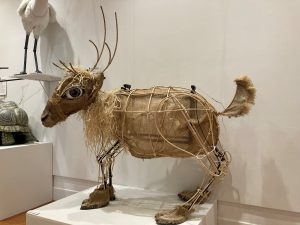
“I like this exhibition because it illustrates the varied areas where puppetry functions – the well-known television and film puppetry, Broadway puppetry, activist puppetry, even mental health puppetry – not just in these different areas but also using so many different techniques,” Bell says. “I’m impressed by the integrity of the designs. These are really well-done puppets.”
“Being part of humankind’s desire to understand the world around them in the earliest tribal gatherings, puppetry has been used for religious beliefs, education, social organization, entertainment, and political commentary,” Roccoberton says. “The expressions of the puppet arts are boundless.”
He continues, “As puppet performers, we must engage the audience’s imagination, so the movements and sounds that we present can be interpreted to lead toward an understanding of intended characters and story. With the audience, we can take journeys of a thousand miles and condense centuries of history in a short time. The puppets can make us laugh and cause us to cry. They can inspire us to action and give us ideas to contemplate. Reality and fantasy are equally expressed through the puppet arts. Well presented puppetry can be magic.”
“Art, Movement, Imagination: 60 Years of UConn Puppeteers” is on display through Oct. 26 at the Ballard Institute and Museum of Puppetry in Downtown Storrs.
